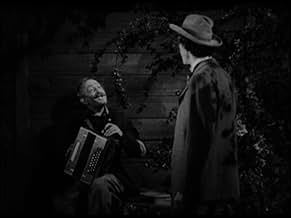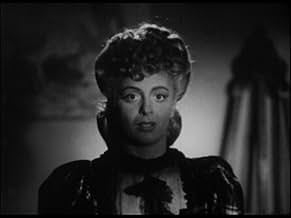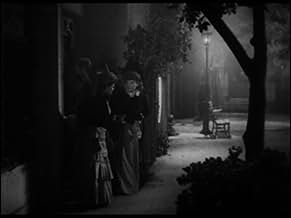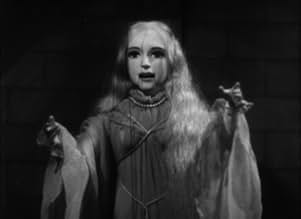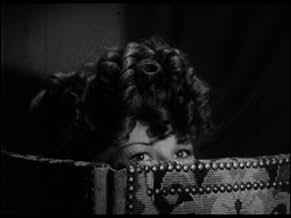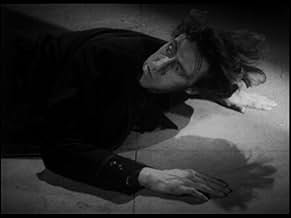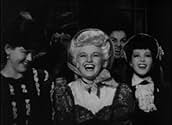IMDb रेटिंग
5.9/10
2.3 हज़ार
आपकी रेटिंग
अपनी भाषा में प्लॉट जोड़ेंIn Paris, an artist hires portrait models, and after he finishes their portraits, he strangles them.In Paris, an artist hires portrait models, and after he finishes their portraits, he strangles them.In Paris, an artist hires portrait models, and after he finishes their portraits, he strangles them.
- निर्देशक
- लेखक
- स्टार
Ludwig Stössel
- Jean Lamarte
- (as Ludwig Stossel)
Harry Cording
- Policeman
- (बिना क्रेडिट के)
Frank Darien
- Inquiry Judge
- (बिना क्रेडिट के)
Bess Flowers
- Courtroom Spectator
- (बिना क्रेडिट के)
Mabel Forrest
- Woman
- (अपुष्टिकृत)
- (बिना क्रेडिट के)
Eddie Hall
- Paul
- (बिना क्रेडिट के)
फ़ीचर्ड समीक्षाएं
Over the years, there have been several notable versions dealing with the story of BLUEBEARD. The most critically acclaimed is Chaplin's MONSIEUR VERDOUX (1947). The most critically reviled is Richard Burton's BLUEBEARD from 1972. In 1960 George Sanders starred in BLUEBEARD'S 10 HONEYMOONS which is an effective, though hard to find, little B movie.
That has not been the case with PRC's BLUEBEARD (1944) starring John Carradine which has been available since the earliest days of TV. I first saw it in 1960 when I was 8. What has not been available, until now, is a decent print of the film. That has been corrected thanks to Kino Lorber with the release of this new Blu-ray.
PRC was known as the bottom rung of the "Poverty Row" ladder. Between 1939 and 1947 they cranked out an astonishing 179 films (that's 22 movies a year) which were shot in less than a week on a budget of less than $100K. Considering that, the look of their movies was very good but after numerous 16mm copies were used on TV, the visual and sonic quality sharply declined.
PRC's sound was never all that good to begin with and wear and tear on the prints made it even worse. I have seen BLUEBEARD many times and from a variety of sources but I have never seen a copy that looked and sounded this good and there are subtitles so at last you can understand what the puppets are singing.
Carradine (who was 38 at the time) gives his finest PRC performance as puppeteer Gaston Morell. He's low key and uses his baritone voice to great effect although that's obviously not him singing. For those who don't know, the opera is Gounod's FAUST. Director Edgar G. Ulmer loved classical music and worked it into his movies whenever he could. The other major theme comes from Mussorgsky's PICTURES AT AN EXHIBITION.
Other cast members include B movie queen Jean Parker as the heroine, former silent screen star Nils Asther as the Inspector, and Ludwig Stossel as the shady Art dealer. The film was photographed by Eugen Schufftan, the great German cameraman who did METROPOLIS, who was not credited due to Hollywood Union rules. The photography and the sets were supervised by director Ulmer.
In 19th century Paris, strangled woman are found floating in the Seine. The police have no clue. Could it be the kindly puppeteer who gives performances in the park? BLUEBEARD is not a horror film nor a mystery but rather a portrait of a tortured but compulsive killer whom we know will get caught in the end. It's the look of the film and Carradine's performance rather than the story that matters.
After years of bouncing around between various owners since PRC went under, BLUEBEARD now belongs to Paramount who has the resources to make it look and sound s good as it does on this Blu-ray. This is really the only way to see this movie. As more and more people are rediscovering the joys of physical media, this Kino Lorber disc is a must for any fan of 1940s B movie horrors...For more reviews visit The Capsule Critic.
That has not been the case with PRC's BLUEBEARD (1944) starring John Carradine which has been available since the earliest days of TV. I first saw it in 1960 when I was 8. What has not been available, until now, is a decent print of the film. That has been corrected thanks to Kino Lorber with the release of this new Blu-ray.
PRC was known as the bottom rung of the "Poverty Row" ladder. Between 1939 and 1947 they cranked out an astonishing 179 films (that's 22 movies a year) which were shot in less than a week on a budget of less than $100K. Considering that, the look of their movies was very good but after numerous 16mm copies were used on TV, the visual and sonic quality sharply declined.
PRC's sound was never all that good to begin with and wear and tear on the prints made it even worse. I have seen BLUEBEARD many times and from a variety of sources but I have never seen a copy that looked and sounded this good and there are subtitles so at last you can understand what the puppets are singing.
Carradine (who was 38 at the time) gives his finest PRC performance as puppeteer Gaston Morell. He's low key and uses his baritone voice to great effect although that's obviously not him singing. For those who don't know, the opera is Gounod's FAUST. Director Edgar G. Ulmer loved classical music and worked it into his movies whenever he could. The other major theme comes from Mussorgsky's PICTURES AT AN EXHIBITION.
Other cast members include B movie queen Jean Parker as the heroine, former silent screen star Nils Asther as the Inspector, and Ludwig Stossel as the shady Art dealer. The film was photographed by Eugen Schufftan, the great German cameraman who did METROPOLIS, who was not credited due to Hollywood Union rules. The photography and the sets were supervised by director Ulmer.
In 19th century Paris, strangled woman are found floating in the Seine. The police have no clue. Could it be the kindly puppeteer who gives performances in the park? BLUEBEARD is not a horror film nor a mystery but rather a portrait of a tortured but compulsive killer whom we know will get caught in the end. It's the look of the film and Carradine's performance rather than the story that matters.
After years of bouncing around between various owners since PRC went under, BLUEBEARD now belongs to Paramount who has the resources to make it look and sound s good as it does on this Blu-ray. This is really the only way to see this movie. As more and more people are rediscovering the joys of physical media, this Kino Lorber disc is a must for any fan of 1940s B movie horrors...For more reviews visit The Capsule Critic.
A PRC poverty row production that makes the most of its limited budget. A lot of credit should go to production designers Eugene Shufftan and Edgar Ulmer who collaborated on the movie's sumptuous look. Even when the middle part drags, the visuals remain arresting. Note too how the meagre exterior sets are stylized to make up for the limitations. Of course, cult director Ulmer was no stranger to transforming army surplus material into artistic effects. The overall result is an atmospheric recreation of 19th century Paris.
Making Carradine's Bluebeard a puppeteer is a novel and interesting wrinkle. Then too, I can't help thinking there is more plot potential in continuing with Bluebeard the puppet master than in shifting the story line over to Bluebeard the painter, as the screenplay does. Nonetheless, those early scenes in the park are good ones. However, the cadaverous actor who can be as florid and intense as anyone seems a little too understated here. While physically he looks the part of the grim reaper, Carradine is simply no good as a simpering lover, while too many of his scenes lack the menace the role calls for. Unfortunately, the result compares unfavorably, for example, with Laird Cregar's riveting Jack the Ripper in that Gothic thriller The Lodger of the same year. It appears Ulmer is much more the visual artist than the thespic coach.
Nonetheless, the movie remains an interesting curiosity. Consider the sheer wackiness of presenting Iris Adrian whose cheap Brooklyn accent can barely be disguised as a Parisian. Still, it does amount to an amusing turn. Also, note the off-angle camera staging of Carradine's flashback sequence, which is both effective in identifying the sequence and artfully composed. Such camera effects were hardly a Hollywood staple at a time when producers generally felt they would confuse the audience.
Of course, there's the question that always arises for fans of Ulmer. What would he have done with an A-budget and A-material in a career spent in the lower depths of Hollywood production. Hard to say-- perhaps he needed the challenge of PRC-type constraints. However, I think it's fair to say that none of his poverty row productions are without genuine points of interest and entertainment, and-- as is the case with Bluebeard-- may even rise at times to artistic levels.
Making Carradine's Bluebeard a puppeteer is a novel and interesting wrinkle. Then too, I can't help thinking there is more plot potential in continuing with Bluebeard the puppet master than in shifting the story line over to Bluebeard the painter, as the screenplay does. Nonetheless, those early scenes in the park are good ones. However, the cadaverous actor who can be as florid and intense as anyone seems a little too understated here. While physically he looks the part of the grim reaper, Carradine is simply no good as a simpering lover, while too many of his scenes lack the menace the role calls for. Unfortunately, the result compares unfavorably, for example, with Laird Cregar's riveting Jack the Ripper in that Gothic thriller The Lodger of the same year. It appears Ulmer is much more the visual artist than the thespic coach.
Nonetheless, the movie remains an interesting curiosity. Consider the sheer wackiness of presenting Iris Adrian whose cheap Brooklyn accent can barely be disguised as a Parisian. Still, it does amount to an amusing turn. Also, note the off-angle camera staging of Carradine's flashback sequence, which is both effective in identifying the sequence and artfully composed. Such camera effects were hardly a Hollywood staple at a time when producers generally felt they would confuse the audience.
Of course, there's the question that always arises for fans of Ulmer. What would he have done with an A-budget and A-material in a career spent in the lower depths of Hollywood production. Hard to say-- perhaps he needed the challenge of PRC-type constraints. However, I think it's fair to say that none of his poverty row productions are without genuine points of interest and entertainment, and-- as is the case with Bluebeard-- may even rise at times to artistic levels.
This is a decent little film but more importantly it's a chance for the star (John Carradine) to show he COULD be a leading man and not just a cheesy supporting actor. In fact, I was THRILLED to see this film because only a couple weeks ago, I saw Carradine's worst film (BILLY THE KID VERSUS Dracula). This film helped to wash away the foul stench of failure from my mind--at least temporarily.
The film is, not surprisingly, a low-budget movie. Carradine played in many of these type of films but this one is different because it is actually well written, acted and engaging. And while it is NOT going to change your life by watching it, it does deliver excellent B-movie thrills.
The film is, not surprisingly, a low-budget movie. Carradine played in many of these type of films but this one is different because it is actually well written, acted and engaging. And while it is NOT going to change your life by watching it, it does deliver excellent B-movie thrills.
John Carradine plays Blubeard--he paints women and then strangles them to death. He doesn't want to do it but is compelled to (we find out why at the end). Then he falls in love with beautiful Lucille (Jean Parker) and tries to fight his desire...
John Carradine said this was his best performance--he's right! He's dead on target in the title role. He shows that Bluebeard is not evil and driven by impulses beyond his control. He uses body language and facial expressions perfectly. Also director Edgar G. Ulmer directs this beautifully with strange camera angles and lots of shadows making this very atmospheric. Also there are some beautifully done background paintings.
But this was done over at PRC--a poverty row studio. Unfortunately it shows. The furnishings and costumes look pretty tacky and it just FEELS low budget. Also the biggest problem is constant background music. It's ALWAYS playing and very annoying. Half the time the music doesn't even match the mood of what's being acted! These prevent the film from becoming a true classic.
As it stands I'm giving it an 8 for Carradine and Ulmer. It should be seen just for them. Also this is one of the few films that prove what a good actor Carradine actually was.
John Carradine said this was his best performance--he's right! He's dead on target in the title role. He shows that Bluebeard is not evil and driven by impulses beyond his control. He uses body language and facial expressions perfectly. Also director Edgar G. Ulmer directs this beautifully with strange camera angles and lots of shadows making this very atmospheric. Also there are some beautifully done background paintings.
But this was done over at PRC--a poverty row studio. Unfortunately it shows. The furnishings and costumes look pretty tacky and it just FEELS low budget. Also the biggest problem is constant background music. It's ALWAYS playing and very annoying. Half the time the music doesn't even match the mood of what's being acted! These prevent the film from becoming a true classic.
As it stands I'm giving it an 8 for Carradine and Ulmer. It should be seen just for them. Also this is one of the few films that prove what a good actor Carradine actually was.
Paris ,France , a tormented painter and puppeteer called Gaston Morrell (one of John Carradine's best vehicles) has a psychopatic urge to strangle gorgeous women . As he contacts Parisian women through his paintings posing as models he seduces and eventually kills them in order to carry out his dark purports . Among those getting the ending curtain call from "bluebeard" (is a type of serial killer ; specifically, it is a man who murders his wives or lovers , this type is named after the fictional "Bluebeard") are Francine Lutien , Lucille Lutien and Renee Claremont .
This chiller is based on lady killer Henry-Denise Landru who seduced and murdered several women . The flick realized Noir style packs thrills , chills , drama , suspense and a lot of murders . Good acting by John Carradine as an artist hires portrait models, and after he finishes their portraits, he strangles them . It features John Carradine's own favorite performance . Furthermore , there appears Jean Parker as Lucille Lutien and Nils Asther and Inspector Jacques . And film debut of actress Sonia Sorel -Mrs. John Carradine- , who went on to do several more titles for director Edgar G. Ulmer.
The failure of the original copyright holder to renew the film's copyright resulted in it falling into public domain, meaning that virtually anyone could duplicate and sell a VHS/DVD copy of the film. Therefore, many of the versions of this film available on the market are either severely and usually badly edited and/or of extremely poor quality, having been duplicated from second- or third-generation or more copies of the film . Eugen Schüfftan was actually the director of photography but could not be credited on screen because he was not yet a member of the cinematographer's union . So he was credited as production designer, the job actually done by director Edgar G. Ulmer, while the camera operator Jockey Arthur Feindel was credited as director of photography . This Noir film was professionally directed by Edgar G Ulmer , being filmed in six days . Edgar was born on September 17, 1904 in Olmütz, Moravia, Czech Republic as Edgar George Ulmer. He was a director and writer, known for Satanás (1934), Detour (1945) and People on Sunday (1930) , Aníbal (1959) , The Amazing Transparent Man (1960) , Beyond the Time Barrier (1960) , among others .
Other films dealing with this known character , Henry ¨Bluebeard¨ Landru , -who was really father of various children, disposed and married 11 wives and killed them in order to feed his little family , being subsequently beheaded- , are the followings : ¨Bluebeard¨ (1901) by George Melies ; ¨Monsieur Verdoux¨ (1947) with Charles Chaplin and Martha Ryer ; ¨Bluebeard's 10 honeymoon¨ by W.L. Wilder with George Sanders , Patricia Roc and Corinne Calvet ; ¨Bluebeard¨(1963) by Claude Chabrol with Charles Denner , Stephane Audran , Danielle Darrieux , Michele Morgan and Hildegarde Neff ; soporific remake titled ¨Bluebeard¨(1972) by Edward Dmytryck with Richard Burton, Joey Heatherton , Rachel Welch , Sybil Danning , Natahalie Delon , Virna Lisi ; and ¨¨Bluebeard¨(2009) by Catherine Breillat with Dominique Thomas and Lola Creton .
This chiller is based on lady killer Henry-Denise Landru who seduced and murdered several women . The flick realized Noir style packs thrills , chills , drama , suspense and a lot of murders . Good acting by John Carradine as an artist hires portrait models, and after he finishes their portraits, he strangles them . It features John Carradine's own favorite performance . Furthermore , there appears Jean Parker as Lucille Lutien and Nils Asther and Inspector Jacques . And film debut of actress Sonia Sorel -Mrs. John Carradine- , who went on to do several more titles for director Edgar G. Ulmer.
The failure of the original copyright holder to renew the film's copyright resulted in it falling into public domain, meaning that virtually anyone could duplicate and sell a VHS/DVD copy of the film. Therefore, many of the versions of this film available on the market are either severely and usually badly edited and/or of extremely poor quality, having been duplicated from second- or third-generation or more copies of the film . Eugen Schüfftan was actually the director of photography but could not be credited on screen because he was not yet a member of the cinematographer's union . So he was credited as production designer, the job actually done by director Edgar G. Ulmer, while the camera operator Jockey Arthur Feindel was credited as director of photography . This Noir film was professionally directed by Edgar G Ulmer , being filmed in six days . Edgar was born on September 17, 1904 in Olmütz, Moravia, Czech Republic as Edgar George Ulmer. He was a director and writer, known for Satanás (1934), Detour (1945) and People on Sunday (1930) , Aníbal (1959) , The Amazing Transparent Man (1960) , Beyond the Time Barrier (1960) , among others .
Other films dealing with this known character , Henry ¨Bluebeard¨ Landru , -who was really father of various children, disposed and married 11 wives and killed them in order to feed his little family , being subsequently beheaded- , are the followings : ¨Bluebeard¨ (1901) by George Melies ; ¨Monsieur Verdoux¨ (1947) with Charles Chaplin and Martha Ryer ; ¨Bluebeard's 10 honeymoon¨ by W.L. Wilder with George Sanders , Patricia Roc and Corinne Calvet ; ¨Bluebeard¨(1963) by Claude Chabrol with Charles Denner , Stephane Audran , Danielle Darrieux , Michele Morgan and Hildegarde Neff ; soporific remake titled ¨Bluebeard¨(1972) by Edward Dmytryck with Richard Burton, Joey Heatherton , Rachel Welch , Sybil Danning , Natahalie Delon , Virna Lisi ; and ¨¨Bluebeard¨(2009) by Catherine Breillat with Dominique Thomas and Lola Creton .
क्या आपको पता है
- ट्रिवियाFeatures John Carradine's own favorite performance.
- गूफ़When the artist is going to paint the model "unobserved", it's done so by arranging mirrors so he can see her but she supposedly can't see him. In reality, however, no matter how many mirrors you use or how you arrange them, if you can see another person in the reflection(s), they can see you.
- भाव
Gaston Morrell: Lucille, I want to tell you something no other living person knows...
- कनेक्शनFeatured in Creature Features: The Mummy (1971)
- साउंडट्रैकFaust
(1859) (uncredited)
Written by Charles Gounod
Excerpts played and sung in English at the marionette show
Excerpts played often in the score
टॉप पसंद
रेटिंग देने के लिए साइन-इन करें और वैयक्तिकृत सुझावों के लिए वॉचलिस्ट करें
- How long is Bluebeard?Alexa द्वारा संचालित
विवरण
- चलने की अवधि1 घंटा 12 मिनट
- रंग
- पक्ष अनुपात
- 1.37 : 1
इस पेज में योगदान दें
किसी बदलाव का सुझाव दें या अनुपलब्ध कॉन्टेंट जोड़ें


